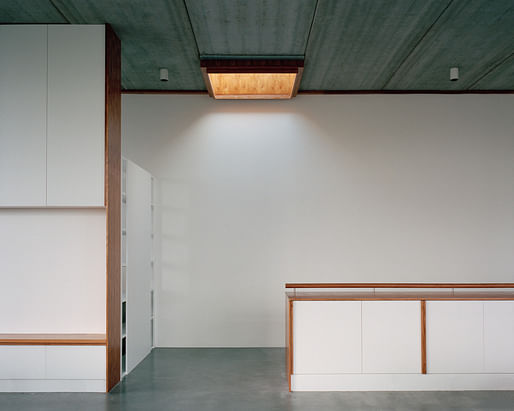
UK architect Peter Besley, a co-founder of Assemblage Studio who now runs his own eponymous architecture practice, has recently completed work on the Couldrey House in Brisbane, Australia.

The 3,400-square-foot, two-and-a-half level home is built out of brick and deploys a selection of earth-bound climate control approaches that include thermal mass, radiant cooling, and passive ventilation strategies.

Besley writes, "I [...] designed Couldrey House to spring directly from the subterranean rock and to be made of heavy materials lasting a very long time," adding, "The forms and spaces are compelling, but simple. They sit heavily on the ground. They seem to say to the landscape: 'I can accompany you in your long journey.'"
Attempting to tap into the overlooked geologic monumentality of the Brisbane area, Besley has created a home that is inward looking and intentionally shuts out the sounds of the city through its massive walls and cloistered internal organization.
"The architecture of Couldrey House is designed to allow visual noise to fall away to heighten awareness of these qualities," Besley writes. "The overall effect of the envelope is sober, and somewhat other-worldly. The masonry was important so the building’s character develops and becomes more nuanced as it weathers and ages, and does not require continual replacement in order to look 'new.' The building should get better, not worse, with time," the architect continues.
The home's materiality enjoys different levels of significance, as Besley expressly chose the flat, off-white brick modules in an effort to undermine local uses of the material, which veer toward the utilitarian. Instead, the architect specified that the excess mortar situated between the bands of brick remain after the modules were laid, resulting in a complex array of mortar "snots" that animate and enliven the building's facades.

"The snots are expressed in the bed joint and not the perpend, giving a strong horizontal effect, like corduroy," Besley explains, "It has the effect of unifying the brickwork, which otherwise presents as its standard unitised, celluraised self."
"Secondly, the projections of the snots catch the strong sunlight and create a visually complex play of shadows. The shadow play is an important part of the ornamentation system of the building. Lastly, the snots are highly irregular, unlike the bricks, and together the textural effect is striking, and starts to form aesthetic allegiances with landscape features. People have likened the brick elevations to tree bark, for example, or sedimentary rock. Children prefer to see it as cake with icing."
The home, which is organized with subterranean bedrooms and shared living spaces on the top floor, is wrapped with planter boxes that will "overrun the masonry envelope" with greenery over time.

"The building stands waiting for endless cycles of weather to be cast down upon it, to gain the finer patinas of age. The mass of the house and its emphatic sense of permanence, the sobriety of its masonry, and the spareness of its form, all give a sense of serene indifference, a quality it draws from the ancient landscape it finds itself in," Besley explains.
6 Comments
can't wait to see this project as it ages...hope they'll make another shoot in 10 years or so. Reminds me of the works of the Dutch Benedictine monk and architect Dom Hans van der Laan, in the best way!
oh wow i haven't thought or heard of Dom Hans van der Laan in so many years. he's the best!
love the mortar expression. In the best material-focused modernist tradition - from Aalto's garage to Kahn to Will Bruder.
It's a handsome house. But, frankly, mis-matched repointing will not speak to timelessness.
can we talk about that Egyptian front door?
this project is fabulous! two thumbs up!
Nice house in many ways. But I'm always bugged by long, horizontal masonry elements that 'float,' like those parapet/spandrels. Even with visible steel beams supporting beneath, it hits me wrong.
Otherwise, I'm in.
Block this user
Are you sure you want to block this user and hide all related comments throughout the site?
Archinect
This is your first comment on Archinect. Your comment will be visible once approved.